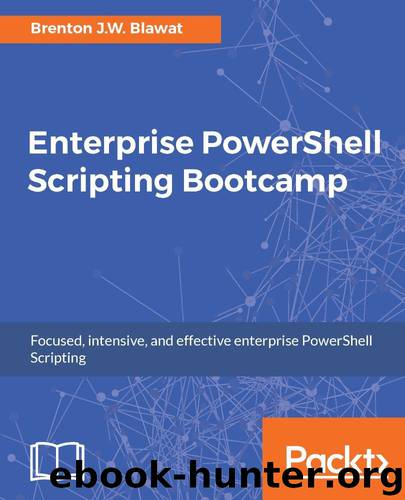Enterprise PowerShell Scripting Bootcamp by Brenton J.W. Blawat

Author:Brenton J.W. Blawat [Blawat, Brenton J.W.]
Language: eng
Format: azw3
Publisher: Packt Publishing
Published: 2017-05-18T04:00:00+00:00
Note
To follow the examples in this chapter, it is recommended that you run the examples on a Windows Server 2012 system. Some of the cmdlets referenced in this chapter are not available in PowerShell 2.0, workstation operating systems, or in operating systems older than Server 2008 R2.
Windows features
When you are trying to determine the function of a Windows server, typically you start by evaluating the Windows features and roles. PowerShell has multiple methods to query server features and roles on a system. The get-WindowsFeature cmdlet, available in Server 2008 R2 and higher, provides a simple display of the features and roles installed on a system. The get-WindowsFeature cmdlet has multiple properties including the DisplayName property, Name property, Installed property, Parent property, and the InstallState property. The DisplayName property is the friendly name of the service. The Name property is the short version of DisplayName. The Installed property is a true or false property that reflects if the feature is installed. The InstallState property provides information as to whether the feature is installed, removed, or available for installation.
To query a server for the installed server features, you can perform the following:
get-WindowsFeature | where {$_.Installed -eq $true} | Select DisplayName, InstallState, Parent
Download
This site does not store any files on its server. We only index and link to content provided by other sites. Please contact the content providers to delete copyright contents if any and email us, we'll remove relevant links or contents immediately.
Test-Driven iOS Development with Swift 4 by Dominik Hauser(7898)
Filmora Efficient Editing by Alexander Zacharias(6559)
The Infinite Retina by Robert Scoble Irena Cronin(6063)
Learn Wireshark - Fundamentals of Wireshark. by Lisa Bock(4390)
Linux Device Driver Development Cookbook by Rodolfo Giometti(4008)
Edit Like a Pro with iMovie by Regit(3822)
Linux Administration Best Practices by Scott Alan Miller(2927)
Linux Command Line and Shell Scripting Techniques by Vedran Dakic & Jasmin Redzepagic(2885)
Mastering PowerShell Scripting - Fourth Edition by Chris Dent(2781)
Creative Projects for Rust Programmers by Carlo Milanesi(2614)
MCSA Windows Server 2016 Study Guide: Exam 70-740 by William Panek(2568)
Docker on Windows by Stoneman Elton(2360)
Kali Linux - An Ethical Hacker's Cookbook: End-to-end penetration testing solutions by Sharma Himanshu(2351)
Hands-On AWS Penetration Testing with Kali Linux by Karl Gilbert(2189)
Hands-On Linux for Architects by Denis Salamanca(2119)
Computers For Seniors For Dummies by Nancy C. Muir(2092)
Programming in C (4th Edition) (Developer's Library) by Stephen G. Kochan(2081)
The Old New Thing by Raymond Chen(2033)
Linux Kernel Debugging by Kaiwan N Billimoria(1812)
